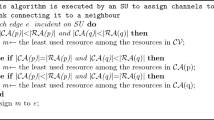Abstract
Cognitive radio (CR) is used to overcome the spectrum scarcity problem, which results from fixed allocation of wireless bands. CR allows the unlicensed secondary users to exploit the idle spectrum, which is not occupied by any licensed primary user (PU), thus increasing the overall spectrum utilization. In this paper, we first propose a simple cooperative sensing algorithm, which combines the local decision at each CR along with a group decision received from a fusion center to produce a collective decision on the existence of the PU. The performance of the algorithm is investigated over ideal and non-ideal reporting channels, from the fusion center to the CR devices, both analytically and via simulations. Furthermore, the effect of cooperation delay, which causes the decisions received by the CR device from the fusion center to be outdated, is extensively studied, both analytically and via simulations. To overcome the significant performance degradation due to the effect of delay, an extra local sensing cycle is performed at the CR side upon reception of the group decision. Results show that the proposed algorithm outperforms the conventional hard decisions technique and exhibits a comparable performance to the soft decisions approach at a considerably lower complexity. Moreover, the algorithm is shown to enjoy more robustness against reporting channel errors than the conventional hard decisions-based algorithm. Finally, the extra sensing cycle is shown to dramatically improve the performance for different delay scenarios.


















Similar content being viewed by others
References
Yucek, T., & Arslan, H. (2009). A survey of spectrum sensing algorithms for cognitive radio applications. IEEE Communications Surveys & Tutorials, 11(1), 116–130.
Urkowitz, H. (1967). Energy detection of unknown deterministic signals. Proceedings of the IEEE, 55(4), 523–531.
Youn, Y., Jeon, H., Choi, J. H., & Lee, H. (2006). Fast spectrum sensing algorithm for 802.22 WRAN systems. In Communications and information technologies, 2006. ISCIT ’06. International symposium on, pp. 960–964.
Abdelmonem, M. A., Nafie, M., Ismail, M. H., & El-Soudani, M. S. (2012). Optimized spectrum sensing algorithms for cognitive LTE femtocells. EURASIP Journal on Wireless Communications and Networking, 2012(1), 1–19.
Tang, H. (2005). Some physical layer issues of wide-band cognitive radio systems. In New frontiers in dynamic spectrum access networks, 2005. DySPAN 2005. 2005 first IEEE international symposium on, pp. 151–159.
Khambekar, N., Dong, L., & Chaudhary, V. (2007). Utilizing OFDM guard interval for spectrum sensing. In Wireless communications and networking conference, 2007. WCNC 2007, pp. 38–42. IEEE.
Kim, K., Akbar, I., Bae, K., Um, J.-S., Spooner, C., & Reed, J. (2007). Cyclostationary approaches to signal detection and classification in cognitive radio. In New frontiers in dynamic spectrum access networks, 2007. DySPAN 2007. 2nd IEEE international symposium on, pp. 212–215.
Yucek, T., & Arslan, H. (2006). Spectrum characterization for opportunistic cognitive radio systems. In Military communications conference, 2006. MILCOM 2006, pp. 1–6. IEEE.
Shankar, N., Cordeiro, C., & Challapali, K. (2005). Spectrum agile radios: Utilization and sensing architectures. In First IEEE international symposium on DySPAN, pp. 160–169. IEEE.
Proakis, J. (2003). Spread spectrum signals for digital communications. New York: Wiley Online Library.
Haykin, S., et al. (2005). Cognitive radio: Brain-empowered wireless communications. IEEE Journal on Selected Areas in Communications, 23(2), 201–220.
Lee, J., Kim, J., Oh, H., & Hwang, S. (2008). Energy detector using adaptive-fixed thresholds in cognitive radio systems. In 14th Asia-Pacific conference on communications. APCC, pp. 1–4. IEEE.
Zhang, S., Dong, X., Bao, Z., & Zhang, H. (2011). Adaptive spectrum sensing algorithm in cognitive ultra-wideband systems. Wireless Personal Communications, 1–22.
Herath, S., Rajatheva, N., & Tellambura, C. (2011). Energy detection of unknown signals in fading and diversity reception. IEEE Transactions on Communications, 59(9), 2443–2453.
Ganesan, G., & Li, Y. (2005). Agility improvement through cooperative diversity in cognitive radio. In: Global telecommunications conference. GLOBECOM’05, Vol. 5, pp. 2505–2509. IEEE.
Ma, J., Zhao, G., & Li, Y. (2008). Soft combination and detection for cooperative spectrum sensing in cognitive radio networks. IEEE Transactions on Wireless Communications, 7(11), 4502–4507.
Atapattu, S., Tellambura, C., & Jiang, H. (2011). Energy detection based cooperative spectrum sensing in cognitive radio networks. IEEE Transactions on Wireless Communications, 10(4), 1232–1241.
Unnikrishnan, J., & Veeravalli, V. (2007). Cooperative spectrum sensing and detection for cognitive radio. In Global telecommunications conference, GLOBECOM’07, pp. 2972–2976, IEEE.
Digham, F. F., Alouini, M.-S., & Simon, M. K. (2007). On the energy detection of unknown signals over fading channels. IEEE Transactions on Communications, 55(1), 21–24.
Sreenivasan, R., Sasirekha, G., & Bapat, J. (2011). Adaptive cooperative spectrum sensing using group intelligence. International Journal of Computer Networks and Communications, 3(5), 31–46.
Ejaz, W., Hasan, N. U., & Kim, H. S. (2013). Distributed cooperative spectrum sensing in cognitive radio for ad hoc networks. Computer Communications, 36(12), 1341–1349.
Kiilerich Pratas, N. (2012). Novel cooperative spectrum sensing methods and their limitations. PhD Thesis, Aalborg University.
Zhao, N., Yu, F., Sun, H., & Nallanathan, A. (2012). An energy-efficient cooperative spectrum sensing scheme for cognitive radio networks. In: Signal processing for communications symposium, Globecom’12, pp. 3624–3628.
Ciftci, S., & Torlak, M. (2008). A comparison of energy detectability models for cognitive radios in fading environments. IEEE conference on global telecommunications, pp. 1–5.
Hu, H., Zhang, H., Yu, H., Xu, Y., & Li, N. (2013). Minimum transmission delay via spectrum sensing in cognitive radio networks. In 2013 Wireless communications and networking conference (WCNC’13), pp. 4101–4106.
Hossain, M., Ahmed, S., Hossain, S., & Abdullah, M. (2012). Performance of cooperative spectrum sensing for different number of CR users in cognitive radio. International Journal of Science and Research (IJSR), 1(3), 144–149.
Ayyub, B. M., & McCuen, R. H. (2011). Probability, statistics, and reliability for engineers and scientists. Boca Raton: CRC Press.
Ghasemi, A., & Sousa, E. S. (2007). Spectrum sensing in cognitive radio networks: The cooperation-processing tradeoff. Wireless Communications and Mobile Computing, 7(9), 1049–1060.
Author information
Authors and Affiliations
Corresponding author
Rights and permissions
About this article
Cite this article
Fahim, M., Ismail, M.H. & Tawfik, H. An Innovative Cooperative Spectrum Sensing Algorithm with Non-ideal Feedback Channels and Delay Considerations. Wireless Pers Commun 78, 313–332 (2014). https://doi.org/10.1007/s11277-014-1755-6
Published:
Issue Date:
DOI: https://doi.org/10.1007/s11277-014-1755-6




